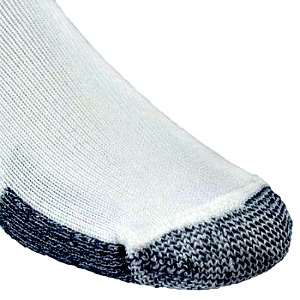The more cushioning for running, the better, right? Wrong. What about thin or thick socks for running? Will the added protection of a thick sock help reduce impact when running? The answer is no because thick protective materials under the foot reduces the plantar sensations needed to activate the withdrawal reflexes in the leg to reduce footfall intensity.
Studies have found that high impact landings during running stems from reduced plantar sensations via thick shoe cushioning which influences injury. So, of course, choose the least amount of under-foot cushioning to help maximize sensory feedback in the sole of the feet so you can land more accurately on your forefoot and avoid injuries.
Thin or Thick Socks for Running?
Socks can be an effective alternative to minimalist running shoes for forefoot running. But, as I stated above, the thinner the sock, the better because you need to learn to land correctly on your forefoot to keep impact low. You cannot rely on protective undefoot materials to do the dirty work for you.
As it turns out, thick socks for running have little effect on reducing the ground reaction force.
 According to a study by Blackmore et al., (2011) thick athletic wool socks were not effective at improving ground reaction force variables compared to barefoot running. That is, running barefoot was just as effective at attenuating shock compared to running in thick socks.
According to a study by Blackmore et al., (2011) thick athletic wool socks were not effective at improving ground reaction force variables compared to barefoot running. That is, running barefoot was just as effective at attenuating shock compared to running in thick socks.
The fact that even the smallest amount of cushioning failed to reduce the ground reaction force during running completely revises the conception that cushioning is imperative for injury prevention.
The researchers reasoned that even though wool is highly resilient, the natural fibers of wool lacks the resiliency to attenuate shock during running. And the fact that the barefoot runners did not show an increase in the ground reaction force reflects that the human foot along with the reflexes controlled by the central nervous system possesses ability to attenuate shock.
Thick Socks Block Proprioception Just Like Running Shoes
The phenomenon of barefoot running resulting in a lower ground reaction force comes down to greater plantar sensory nerve stimulation, which produces low impact forefoot running mechanics.
- Barefoot running accounts for very precise foot-ground interactions, allowing a runner to obtain a forefoot strike rather than a heel strike, whereas running in thick cushioned footwear results in a blockage of certain plantar sensory nerves, resulting high impact, heel strike landings that cause injury.
Thick socks for running are not useful at reducing the ground reaction force because they impair tactile sensibility along the plantar surface thereby disturbing landing strategy.
The typical landing strategy of a runner wearing cushioning under the foot is a heel strike landing pattern which generates a higher magnitude of the ground reaction force than a forefoot strike.
When running barefoot, the body has its own novel mechanism at landing safely to which still remains underappreciated among the running community.
The Take Home Message
Ideal foot touchdown angles and safe landing behavior in running are derived under barefoot conditions whereas thick socks acts as a barrier between the interplay of the sensory receptors in the foot and the ground.
Barefoot running enhances the body’s ability to reflexively improve shock attenuation and resolve discomfort whereas thick socks not only lack the material to attenuate force during running, they bear plantar sensory consequences of impact by encouraging heel strike.
More From Run Forefoot:
References:
Blackmore, T., Ball, N and Scurr, J. The effect of socks on vertical and anteroposterior ground reaction force in walking and running. The Foot, 2011, 1–5.
Dai et al. Effect of sock on biomechanical responses of foot during walking. Clin Biomech, 2007; 21:314–21.
Robbins, SE., Gouw, GJ and Hanna, AM. Running-related injury prevention through inmate impact moderating behavior. Med Sci Sports Exerc, 1989; 21:130–139.
Bretta Riches
BSc Neurobiology; MSc Biomechanics candidate, ultra minimalist runner & founder of RunForefoot. I was a heel striker, always injured. I was inspired by the great Tirunesh Dibaba to try forefoot running. Now, I'm injury free. This is why I launched Run Forefoot, to advocate the health & performance benefits of forefoot running and to raise awareness on the dangers of heel striking, because the world needs to know.
Latest posts by Bretta Riches (see all)
- How to Train Yourself to Not Heel Strike When Running - 24/04/2024
- Cushioned Running Shoes Found to Be Bad for Ankles - 23/04/2024
- Forefoot Running and Achilles Pain - 19/04/2024

Leave a Reply